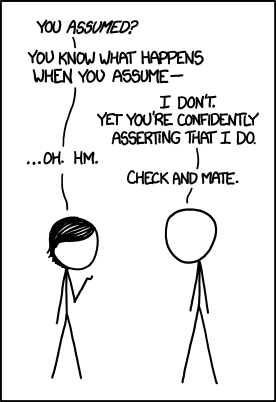Hey GMATters,
This post is 3200 words (nineteen flippin’ pages, yo). Want a PDF instead? Grab one here:
Critical Reasoning is a tricky subject, no doubt about it.
First, you need to learn to break apart the arguments.
Second, you need to be able to eliminate the objectively incorrect answers (that’s a subject for another guide).
While if you’re going for quick effect, you can jump to answer elimination. This certainly do more damage more quickly.
However, let’s start by addressing…
How to Break Apart Arguments
It’s all about Fact vs. Assumption vs. Conclusion. Generally, a GMAT-style argument will be in the following form:
1) Premise (fact or assumption)
2) Premise (fact or assumption)
3) Conclusion
Ultimately, this comes from the fact that the GMAT deals in inductive logic rather than deductive logic.
Important Detour: Inductive vs. Deductive Logic
Let’s do this quickly: you’ll need to know the terminology to proceed, so let’s address what Deductive and Inductive logic are.
Deductive Logic is straightforward organization of information.
Most of us know “deductive logic” from Sherlock Holmes’ dubious claims that his detective work was “deduction.”
We’ll leave it at that, since Holmes’ claim is as technically accurate as Alanis Morrissette’s definition of “irony.”
In other words, Deductive Logic is like an Algebra problem: all of the stuff is already there on the page; you’re just reorganizing to solve for X. There is no new information created.
You’re simply rearranging what is there in a new, more convenient form.
Inductive Logic is inferential: it requires a guess (and a test).
Inductive Logic works from empirical information, recognizes patterns, and makes an “educated guess” based on the information provided.
This guess creates new information.
Crucial: a computer is not capable of inductive logic.
Inductive logic can be best described as “an educated guess.” That is, since the Sun has risen every day for the past six billion years, I induce that the sun will rise tomorrow.
Of course it is possible—although exceptionally unlikely—that the Sun will not rise tomorrow: perhaps someone pushes that Giant Red Button while we’re all asleep and blows the Earth right out of its orbit.
Wait–how does Amazon know what I want to buy next?
Permit me a little correction: Amazon does not “know what you want to buy”; rather, based on your previous preferences and shitloads of data from literally billions of other purchases, it’s actually using statistical likelihood to put things in front of you that “you might like.” If it gets it right, you think it’s guessing well.
We won’t bother with getting into details about how using statistical likelihood differs from induction, but let’s note one important thing—you probably guessed already—statistical likelihood is deductive.
In short, computers with complicated-enough deductive systems try to approximate Inductive Logic, which is a reductive-but-effective way to state the main goal of Artificial Intelligence research. As soon as AI researchers succeed in creating a true Inductive Computer, we’ll all be fighting Skynet together.
Logical Leaps
The ultimate point of Inductive Logic is that there is a logical leap involved. We have to make the educated guess—the assumption—that because something has repeatedly been true that it will continue to be true.
That leap can be realistic, as in our previous example, or it can be completely insane (just ask people who think that Elvis and Tupac are still alive).
However, the GMAT tends to find situations where the leap seems more reasonable than it really is: that is, the argument’s leap “seems OK,” but it often still allows circumstances where the facts can be true yet the conclusion is still false.
(Notice how I keep repeating that last bit?)
What is a fact?
A fact is something that is objective and measurable. That is, a fact is something that you can take a photograph of, write down, place in an Excel spreadsheet, or otherwise record.
What a fact is not: an assumption, a conclusion, or a claim. That is, it is something that cannot be disputed unless proven untrue.
What is an assumption?
An assumption is a nebulous concept—at its most basic, you can think of it as something that “holds facts together.”
Another way to think about it is that facts themselves are like carved pieces of wood that make a chair.
Now the better the woodcarver has made the pieces, the better they fit together.
That’s not to say that there will be no spaces—even in the best-made furniture, there will be spaces at some level.
However, a great craftsman (or craftswoman!) can make a chair without using any glue at all—simply because these pieces fit together so snugly, they make a sturdy chair that can support a huge amount of weight.
An assumption, on the other hand, is like the glue. When the chair pieces are poorly carved, the glue is necessary to hold it together.
If the pieces don’t really fit together and there is a lot of space that needs glue, the chair doesn’t support much weight at all.
In fact, the more glue there is for a given number of pieces, the less weight the chair will hold.
Arguments work like this: the more snugly facts fit together, the less room there is for misinterpretation or false conclusions.
In other words, the closer-fit the facts are, the sturdier the arguments!
In other other words, the broader the assumption in an argument, the weaker the argument.
To paraphrase that dumbass teacher you had in high school (you know which one I’m talking about): “When you assume, you make an ASS out of U and ME.”
(from: https://xkcd.com/1339/)
But what if there aren’t enough facts?
This leads us to my favorite GMAT logic analogy: conspiracy theory.
Philosopher Robert Anton Wilson often suggested the study of conspiracy theory as a means to improve one’s logic.
That’s not learning to believe in crazy-ass ideas, but rather as an exercise in skepticism. In other words, it helps us define how much we actually do and do not know.
Conspiracy theories arise from situations where we have a limited number of facts.
That is, there simply aren’t enough pieces to the chair to make it stand on its own, so it needs quite a lot of glue!
Clever conspiracy theorists are able to implicate UFOs, Elvis, or even elves in the JFK assassination or Kurt Cobain’s suicide. Why?
Because there are still unanswered questions. There aren’t enough facts available to lead to a definitive conclusion.
What we take as a “definitive conclusion” is no more “fact” than the ravings of some lunatic standing on a soap box on the streetcorner.
What does an acceptable story have that a nutbag story doesn’t have?
Well, like it or not, it just “seems more reasonable.” Does that make it more true? Does that make it deductively true? Absolutely, positively, NO.
Remember, any story has room for misinterpretation. Don’t let it hurt your brain too much, but we make a lot of guesses to keep things running smoothly in life.
For example, when I order a coffee in an English-speaking country, I tend to speak English. However, I speak French sufficiently well to order my coffee in French. It’s even possible that the barista also speaks French.
If both of those facts were true, I could potentially order in French and have the order communicated appropriately. Yet, realistically, if I don’t know the barista speaks French—and even if I do—there’s no reason to assume I won’t order in English.
After all, we’re in an English-speaking country. The general background language would be a Reasonable Assumption.
What is a Reasonable Assumption?
A Reasonable Assumption is effectively a situation where the assumption is treated as a fact because there are so bloody few exceptions that we might as well say those exceptions simply don’t exist.
Unfortunately, as you get better at Critical Reasoning, you’ll butt up against what the GMAT decides is “reasonable.” It’s very likely that as your logic gets sharper, you’ll start to cut just a bit too fine.
In other words, you’ll start to see assumptions that the GMAT considers “reasonable.” It’s only natural, because (in my own arrogant opinion) the test-writers just don’t think all that carefully about the distinction between Fact and Assumption and they more or less consider Reasonable Assumptions to be facts. So it goes…
My advice: do as many OFFICIAL GMAC[1] Critical Reasoning questions as possible.
When you cut too fine, you’ll always be choosing between the Almost Correct answer and the Correct answer. Take the time to define—in writing (say two or three sentences)—why the book’s answer is correct and your answer is incorrect.
After 50-75 questions, you’ll begin to understand, intuitively, where the testwriters draw their lines for what a Reasonable Assumption entails.
But Why Again with the Conspiracy Theories? You crazy.
Be that as it may, let’s focus. Put your phone away and listen.
To answer the question: it’s often useful to think of the wacky, “out there” scenarios in GMAT questions because this tests the boundaries of the logic that the test-writers have used.
Remember, a good argument leads directly to a particular conclusion. If it allows for any deviance, seemingly crazy or not, it is not an acceptable argument.
Aristotle has a lot to answer for.
The GMAT knows this, and loves to capitalize on it.
Most of the logical mistakes that we make in Critical Reasoning can be traced back to one thing, which has its roots in Aristotle’s work 2300 years ago.
Let’s look at Aristotle’s argument in short:
1) The world has an inherent, objective structure outside of what we perceive.
2) The human mind is able to take particulars—that is, what we perceive—and generalize based on these.
3) We are able to attain knowledge of universal truths by generalizing based on these particulars.
Seem reasonable? While many thousands of volumes have been written on the problem with each of these statements, the GMAT is really only concerned with a tiny bit of this argument: the relationship between parts 2) and 3).
In short, in Critical Reasoning questions, we are given certain statements that are presented as fact. We are asked to generalize based on these statements.
However, it is possible that our generalizing is somehow flawed: are we legitimately always reaching universal truths? Hardly.
A classic example would be the old “correlation vs. causation” argument. That is, just because two things happen at the same time does not necessarily mean that one of these things causes the other—or, for that matter, that they are even related in the first place.
Consider this example:
Most vandalism in Town X occurs in the daytime. On any given day, up to 5% of teenagers in Town X are absent from school. Therefore, the teenagers who are skipping school are responsible for this vandalism.
If you see the problem here, great.
While it’s not necessarily untrue that the teenagers are causing the vandalism, it’s certainly not always the case. Think about it: is there possibly, just maybe, someone else who might be responsible? Could teenagers be absent for legitimate reasons such as illness?
Therefore, it’s pretty clear that we’re not always reaching “universal truths” by linking these facts. That’s not to say that we’re always wrong, but we need a more effective way to figure out when we are.
That’s the whole point of the Critical Reasoning section on the GMAT—we need to test the arguments to make sure that they actually hold water!
The best method to do this is found here… in the missing section of this blog post! Thanks TopMBA!
(of course you could just download the PDF for your convenience…)
By negating the conclusion, it immediately becomes a lot simpler to be able to identify our invalid Assumption.
Another word for it would be The Counterexample.
In fact, you may have heard of this, and sometimes the Counterexample comes to you without trying. At a certain level of preparation, this should begin to happen more and more.
(That’s a good thing!)
However, whether we like it or not, that’s an intuitive method.
The worst problem with the GMAT is that intuition is at once our best friend but it also tends to be the first thing to disappear when Stress rears its ugly head.
That’s the whole point of applying Reduction to Absurdity!
Thank Aristotle.
Our friend from Antiquity has absolved himself for his Crimes of Induction by giving us the tool to crack open bad arguments.
Next time you’re stuck, just remember the absurd (and give a hat tip to old Artistotle): if the conclusion and its negation are both possible, this argument isn’t going to fly.
Remember: it doesn’t have to be hard.
Enjoy this guide? Check out more at www.yourgmatcoach.com, including free guides and information on how to work with Rowan directly!
[1] If you’re doing non-Official questions, it’s your funeral. How are you going to be able to tell the difference between you not seeing appropriate logic and the writer of the question just being an idiot? Official questions are solid and extremely well-edited. Use them.
Whew! You’re done! Want to refer back to this How to Find Any Assumption in Critical Reasoning Guide at your convenience? Get a PDF copy here:




